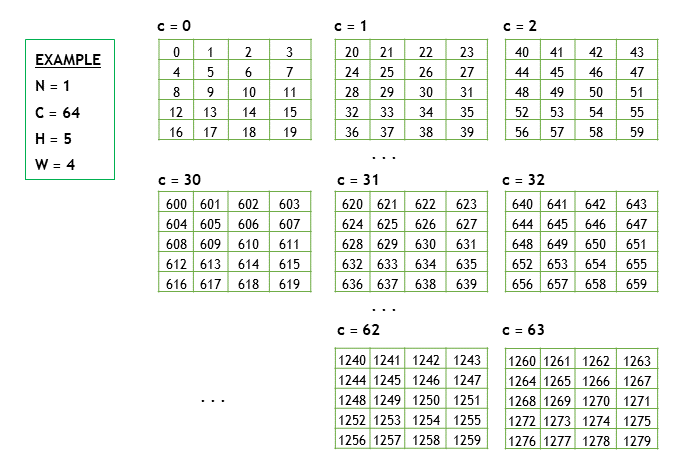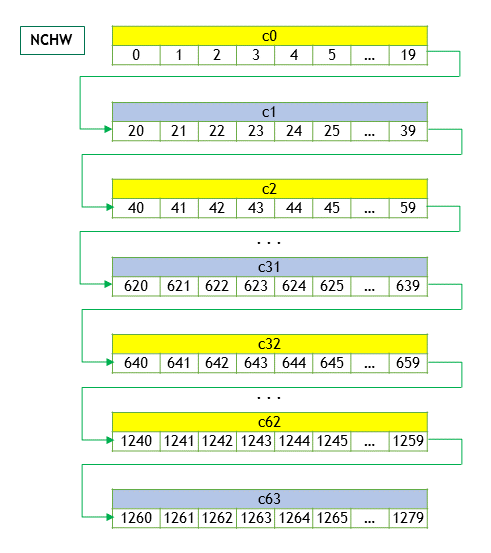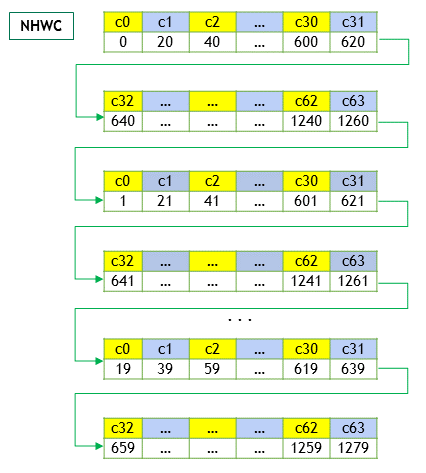Understand Tensor Data Layout
Summary
本文介绍了pytorch中常用的两种内存存储形式NCHW和NHWC,深入讨论了Stride和Contiguous等概念,并解释了改变Tensor内存结构的原理和过程。
实例引入
假设有一个NCHW的Tensor X, X.shape = [1, 64, 5, 4],行优先排序(row-major),如下图所示

其内存排序如图所示(优先访问W、H,然后通道C +=1)

如果它是以NHWC的形式排布,那么将变为(优先访问不同通道的数据,然后再W、H+=1)

Stride, Contiguous介绍
import torch
N, C, H, W = 1, 64, 5, 4
x = torch.rand(N, C, H, W)
print(x.shape) # torch.Size([1, 64, 5, 4])
print(x.stride()) # (1280, 20, 4, 1)
print(x.contiguous()) # TrueStride即在内存中需要迈出去的步长,其计算方式如下
size_t stride = 1;
for (int i = ndim_ - 1; i >= 0; i--) {
stride_[i] = stride;
stride *= shape_[i];
}例如,每要取下一个H的值,我们知道要遍历4个行元素(W=4),那么我们就可以根据stride[2]=4直接拿到这个值,并让内存指针加4,获取到我们需要的元素。再比如要取下一个C,内存指针直接+20,就可以取到对应值。
Contiguous即内存空间排布是否连续,因为我们是行优先,所以能按照行的顺序访问即符合连续定义,是否连续判定代码如下:
bool is_contiguous() const {
size_t stride = 1;
for (int i = ndim_ - 1; i >= 0; i--) {
if (stride_[i] != stride) {
return false;
}
stride *= shape_[i];
}
return true;
}一般地,对tensor的操作(如transpose、permute等)只改变tensor的描述(shape、stride),不会改变tensor实际内存结构。例如:
import torch
N, C, H, W = 1, 3, 2, 2
x = torch.randint(1,30,(N, C, H, W))
print(x.is_contiguous()) # True
print(x.storage()) # [25, 29, 28, 6, 12, 25, 4, 20, 17, 21, 19, 5]
print(x.shape) # torch.Size([1, 3, 2, 2])
print(x.stride()) # (12, 4, 2, 1)
x = torch.transpose(x, 0, 2)
print(x.is_contiguous()) # False
print(x.storage()) # [25, 29, 28, 6, 12, 25, 4, 20, 17, 21, 19, 5]
print(x.shape) # torch.Size([2, 3, 1, 2])
print(x.stride()) # (2, 4, 12, 1)然而memory format的变更不仅改变tensor的描述,还需要直接改变tensor的storage,如下文中NCHW和NHWC之间的转换就改变了内存结构。
NCHW 和 NHWC 之间的转换
import torch
N, C, H, W = 1, 64, 5, 4
x = torch.rand(N, C, H, W)
x = x.contiguous(memory_format=torch.channels_last)
print(x.shape) # torch.Size([1, 64, 5, 4])
print(x.stride()) # (1280, 1, 256, 64)
print(x.is_contiguous()) # False可以看到,shape没有发生改变,而stride从(1280, 20, 4, 1)变为了(1280, 1, 256, 64)
该stride变化是如何产生的呢?请看下面的代码
int64_t stride = 1;
for (auto k : {1, 3, 2, 0}) {
strides[k] = stride;
stride *= shapes[k];
}即优先访问C上元素,再访问W、H最后访问N。
是怎么通过stride实现这样优先访问的呢?我们首先要了解它是如何取值的
// 通过索引取值
data_t operator[](std::vector<size_t> idxs) const {
size_t offset = 0;
for (size_t i = 0; i < ndim_; i++) {
offset += idxs[i] * stride_[i];
}
return data_[offset];
}例如,用户访问tensor_channel_last[0,1,0,0]的数据,想获取下一个c的值,那么offset = 1280 * 0 + 1 * 1 + 256 * 0 + 64 * 0 = 1,正好取到了offset=1的数据
这里就引出了一个疑问,数据指针offset=1不是指向w=1的值吗?所以当变更为channel-last之后,数据在内存一维数组上的排布也发生了改变,以符合适配的offset。
我们取一个小一点的tensor来分析内存排布
import torch
N, C, H, W = 1, 3, 2, 2
x = torch.randint(1, 30, (N, C, H, W))
print(x.storage()) # [ 14 16 20 11 8 26 15 18 29 21 10 3]
x = x.contiguous(memory_format=torch.channels_last)
print(x.storage()) # [ 14 8 29 16 26 21 20 15 10 11 18 3]可以看到,原本索引为4的8(对应c1h0w0)现在索引变为了1,正好与新的stride适配。
为什么要做NCHW和NHWC的区分和转换——性能上的提升
在部分算子运算时,其实更需要获取下一维度的C,如果按照continuous取法,那么偏移量为H*W,虽然取值仍然是O(1),但却无法命中缓存导致性能下降。转换为NHWC后,每一次取C的值都会变得很便利。
根据pytorch文档显示,和AMP(Automated Mixed Precision,自动混合精度)一起使用的时候,在NVIDIA GPU上可以取得22%的性能提升。即使只在CPU上,也能因为更好命中缓存而取得性能提升。